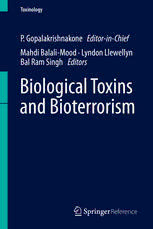Table Of ContentToxinology
P. Gopalakrishnakone Editor-in-Chief
Mahdi Balali-Mood · Lyndon Llewellyn
Bal Ram Singh Editors
Biological Toxins
and Bioterrorism
1 3
Reference
Toxinology
Editor-in-Chief
P.Gopalakrishnakone
Inrecentyears,thefieldoftoxinologyhasexpandedsubstantially.Ontheonehand
it studies venomous animals, plants and micro organisms in detail to understand
their mode of action on targets. While on the other, it explores the biochemical
composition, genomics and proteomics of toxins and venoms to understand their
threeinteractionwithlifeforms(especiallyhumans),developmentofantidotesand
exploringtheirpharmacologicalpotential.Therefore,toxinologyhasdeeplinkages
with biochemistry, molecular biology, anatomy and pharmacology. In addition,
there is a fast-developing applied subfield, clinical toxinology, which deals with
understanding and managing medical effects of toxins on human body. Given the
huge impact of toxin-based deaths globally, and the potential of venom in gener-
ation of drugs for so-far incurable diseases (for example, diabetes, chronic pain),
the continued research and growth of the field is imminent. This has led to the
growth of research in the area and the consequent scholarly output by way of
publications in journals and books. Despite this ever-growing body of literature
within biomedical sciences, there is still no all-inclusive reference work available
that collects all of the important biochemical, biomedical and clinical insights
relatingtotoxinology.
Composed of 11 volumes, Toxinology provides comprehensive and authoritative
coverage of the main areas in toxinology, from fundamental concepts to new
developmentsandapplicationsinthefield.Each volumecomprisesafocusedand
carefullychosencollectionofcontributionsfromleadingnamesinthesubject.
SeriesTitles
1.BiologicalToxinsandBioterrorism
2.ClinicalToxinologyintheAsiaPacificandAfrica
3.SpiderVenoms
4.ScorpionVenoms
5.MarineandFreshwaterToxins
6.VenomGenomicsandProteomics
7.SnakeVenoms
8.EvolutionofVenomousAnimalsandTheirVenoms
9.MicrobialToxins
10.PlantToxins
11.ToxinsandDrugDiscovery
Moreinformationaboutthisseriesathttp://www.springer.com/series/13330
P. Gopalakrishnakone
Editor-in-Chief
Mahdi Balali-Mood (cid:129) Lyndon Llewellyn
Bal Ram Singh
Editors
Biological Toxins and
Bioterrorism
With123Figuresand30Tables
Editor-in-Chief
P.Gopalakrishnakone
VenomandToxinResearchProgramme
DepartmentofAnatomy
YongLooLinSchoolofMedicine
NationalUniversityofSingapore
Singapore
Editors
MahdiBalali-Mood BalRamSingh
MedicalToxicologyResearchCentre BotulinumResearchCenter
FacultyofMedicine InstituteofAdvancedSciences
MashhadUniversityofMedical Dartmouth,MA,USA
Sciences PrimeBio,Inc.
Mashhad,Iran Dartmouth,MA,USA
LyndonLlewellyn
DataandTechnologyInnovation
AustralianInstituteofMarineScience
Townsville,QLD,Australia
ISBN978-94-007-5868-1 ISBN978-94-007-5869-8(eBook)
ISBN978-94-007-5870-4(printandelectronicbundle)
DOI10.1007/978-94-007-5869-8
SpringerNewYorkHeidelbergDordrechtLondon
LibraryofCongressControlNumber:2014950636
#SpringerScience+BusinessMediaDordrecht2015
Thisworkissubjecttocopyright.AllrightsarereservedbythePublisher,whetherthewholeorpartof
the material is concerned, specifically the rights of translation, reprinting, reuse of illustrations,
recitation,broadcasting,reproductiononmicrofilmsorinanyotherphysicalway,andtransmissionor
informationstorageandretrieval,electronicadaptation,computersoftware,orbysimilarordissimilar
methodologynowknownorhereafterdeveloped.Exemptedfromthislegalreservationarebriefexcerpts
inconnectionwithreviewsorscholarlyanalysisormaterialsuppliedspecificallyforthepurposeofbeing
enteredandexecutedonacomputersystem,forexclusiveusebythepurchaserofthework.Duplication
ofthispublicationorpartsthereofispermittedonlyundertheprovisionsoftheCopyrightLawofthe
Publisher’s location, in its current version, and permission for use must always be obtained from
Springer.PermissionsforusemaybeobtainedthroughRightsLinkattheCopyrightClearanceCenter.
ViolationsareliabletoprosecutionundertherespectiveCopyrightLaw.
The use of general descriptive names, registered names, trademarks, service marks, etc. in this
publicationdoesnotimply,evenintheabsenceofaspecificstatement,thatsuchnamesareexempt
fromtherelevantprotectivelawsandregulationsandthereforefreeforgeneraluse.
While the advice and information in this book are believed to be true and accurate at the date of
publication,neithertheauthorsnortheeditorsnorthepublishercanacceptanylegalresponsibilityfor
anyerrorsoromissionsthatmaybemade.Thepublishermakesnowarranty,expressorimplied,with
respecttothematerialcontainedherein.
Printedonacid-freepaper
SpringerispartofSpringerScience+BusinessMedia(www.springer.com)
Series Preface
The term TOXIN is derived from the Greek word Toeikov and is defined as a
substance derived from tissues of a plant, animal, or microorganism that has a
deleterious effect on other living organisms. Studying their detailed structure,
function,andmechanismofactionaswellasfindinganantidotetothesetoxinsis
thefieldofTOXINOLOGY,andthescientistsarecalledTOXINOLOGISTS.
Inrecentyears,thefieldoftoxinologyhasexpandedsubstantially.Ontheonehand,
itstudiesvenomousanimals,plants,andmicroorganismsindetailtounderstandtheir
habitat,distribution,identification,aswellasmodeofactionontargets,whileonthe
other,itexploresthebiochemicalcomposition,genomics,andproteomicsoftoxins
andvenomstounderstandtheirinteractionwithlifeforms(especiallyhumans),the
development of antidotes, and their pharmacological potential for drug discovery.
Therefore,toxinologyhasdeeplinkageswithbiochemistry,molecularbiology,anat-
omy, pharmacology, etc. In addition, there is a fast-developing applied subfield,
clinical toxinology, which deals with understanding and managing medical effects
ofvenomsandtoxinsonthehumanbodyfollowingenvenomations.Giventhehuge
impact of envenomation-based deaths globally and the potential of venom in the
generationofdrugsfordebilitatingdiseases(e.g.,diabetes,chronicpain,andcancer),
thecontinuedresearchandgrowthofthefieldareimminent.
Springerhastakentheboldinitiativeofproducingthisseries,whichisnotaneasy
target of producing about 11 volumes, namely, biological toxins and bioterrorism,
clinical toxinology, scorpion venoms, spider venoms, snake venoms, marine and
freshwater toxins, toxins and drug discovery, venom genomics and proteomics,
evolutionofvenomousanimalsandtheirtoxins,planttoxins,andmicrobialtoxins.
Singapore P.Gopalakrishnakone
MBBS,PhD,FAMS,DSC
Editor-in-Chief
v
Acknowledgments
I would like to sincerely thank the section editors of this volume, Mahdi Balali-
Mood, Lyndon Llewellyn, and Bal Ram Singh, for the invaluable contribution of
theirexpertiseandtimeandtheauthorswhoobligedwithmyrequestandprovided
acomprehensivereviewonthetopics.
Springer provided substantial technical and administrative help by many indi-
vidualsatvaryinglevels,butspecialmentionshouldgotoMokshikaGaur,Meghna
Singh,andAudreyWongfortheirtirelesseffortinbringingthesevolumestoreality.
Singapore P.Gopalakrishnakone
MBBS,PhD,FAMS,DSC
Editor-in-Chief
vii
Volume Preface
Biotoxinsareanimportantpartofourworld,arealitywithwhichweneedtocope,
soinparallelwithunderstandingtheirmechanismsofactionandtherebyimproving
our fundamental knowledge, there are successful efforts to utilize them as thera-
peuticsagainstsomedebilitatinghumanandanimaldiseases.Overthepastseveral
decades,researchersthroughouttheworldhavedevelopedtechniquesandtoolsto
detect these toxins, modify them for specific uses, and develop countermeasures
againsttheireffectssothattheirimpactscanbemanaged.
After the use of chemical warfare agents during World War I,all nations were
againstanychemicalweapon.InspiteoftheGenevaProtocolin1925andfurther
chemicalandbiologicalweaponconventionsandconferences(thelatestoneheldin
2011) in the last century, both chemical and biological warfare agents were
unfortunately applied in war (Iraq-Iran conflict) and terrorism (Matsomoto and
Tokyo metro). Due to the application of high technology in biotoxin production,
biowar and bioterrorism are now an even bigger threat than chemical war and
terrorism. Biotoxins may be abused as bioweapons. As a result, government
agencies needed to address it and have developed policies and regulations to
allowresearchonthesetoxinssmoothly.
Inviewofthecomplexityofdifferenttypesofbiotoxinsandthebroadrangeof
toxin structure, physiology, utility, and countermeasures including regulatory
issues,itwasthusaimedtocompileabookonbiotoxinsandbioweapons.
Somebiotoxinsarehighlypotentwhenadministeredtovictimsviaavarietyof
routes and can often be manufactured by means available to even the simplest
laboratory,makingthemidealcandidatesforweaponization.Buttheirutilityisnot
solely as weapons. Their exceptional ability to attack physiological mechanisms
critical to our survival has allowed us to probe the molecular structures of the
enzymes andreceptorstheyattack,improvingourunderstanding ofourselvesand
thebiodiversityimportanttopeopleeverywhere.Thesenaturalchemicalscanalso
intrudeintoourdailylivesbycontaminatingourfoodandwatersupplies,beingthe
instrumentbywhichadiseasepathogencansickenusandallowingsomeanimalsto
defendthemselvesagainstpredatorsorsubduetheirprey.
ix

